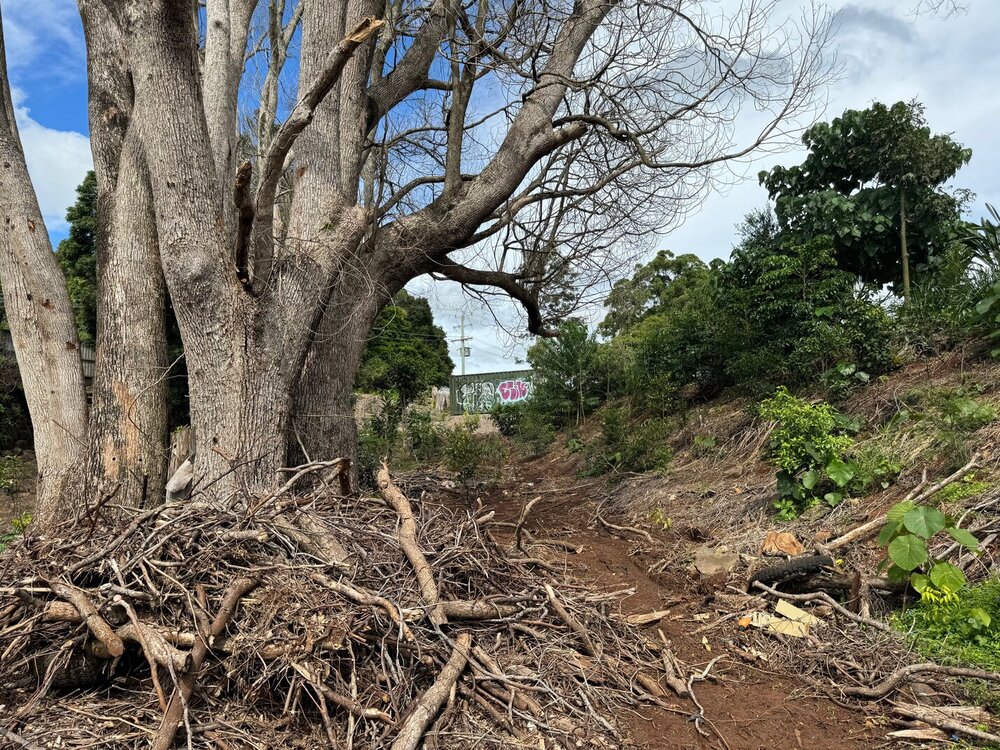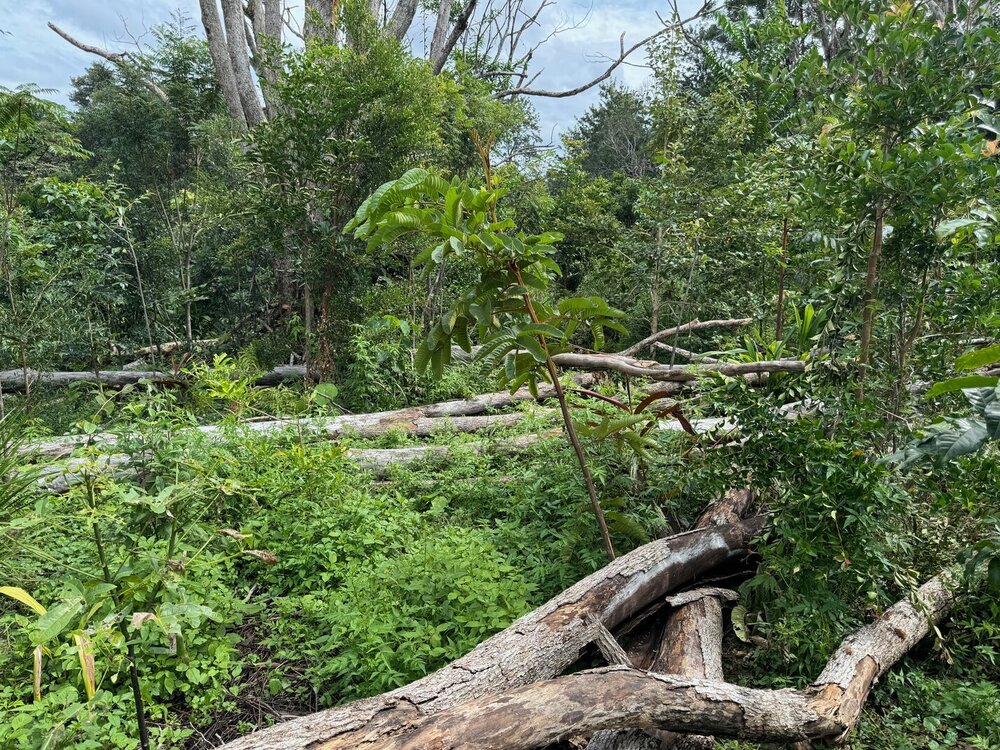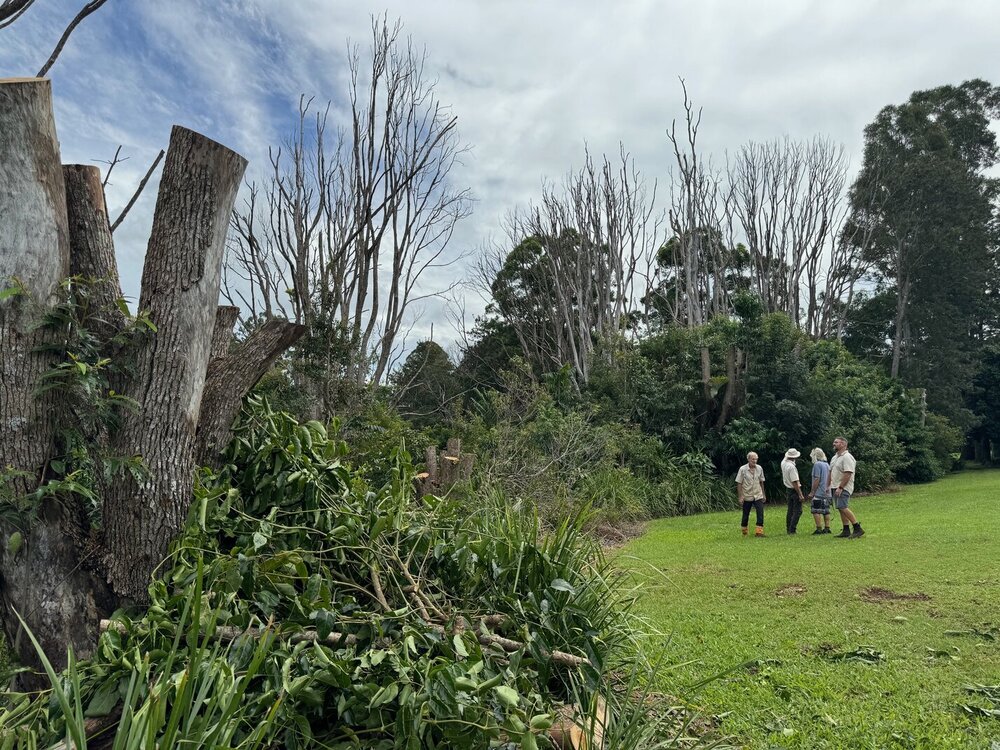Local Landcare Group unhappy after council destroys years of hard work
Simon Mumford
08 April 2024, 9:03 PM

This article inadvertently implied, through wording about Lismore City Council's Environment Team, that Lismore-based environmental consultancy Ecoteam was involved in the cutting down of camphor laurels on the Birdwing Butterfly Walk area. This is not the case, Ecoteam - which is dedicated to finding natural solutions to environmental challenges, and in particular, those relating to water - had no involvement in the Council-sanctioned chainsawing. The Lismore App apologises for any confusion that may have arisen as a result.
The Goonellabah Tucki Landcare Group is ropeable after the Lismore City Council Environment and Eco team destroyed two sections of hard work that took years to prepare, clear, and plant.
In January, President Doug Blythe and Secretary Shaen Springall won the Environment Award at this year's Australia Day Awards for their work on the 2km Goonellabah Tucki Tucki Creek area over the last ten years.
It was mentioned that the group has planted over 30,000 rainforest trees and raised over $50,000 in the last three years. They devote themselves to maintaining and improving the area and have formed strong connections with community groups and schools.
Shaen and Doug stood in disbelief recently when they discovered a number of fallen camphor laurel trees in two areas of Tucki Tucki Creek with no regard to the work already completed by the Gonellabah Tucki Landcare Group.
The first incident occurred near the Goonellabah dog park.
According to Shaen Springall, they had a meeting with the council and had agreed on a plan to make the area safe and create another part in the 2km natural rainforest regeneration.
"Last year, we were approached by these two homeowners to get rid of the camphor laurels behind their place," Shaen explained.

(The dead camphor laurels with the properties in question to the right)
Tucki Tucki Creek was being overrun by noxious weeds that are toxic to the environment, such as lantana, privet and camphor laurel trees.
Shaen and Doug, along with many other volunteers, have been slowly killing and removing these weeds and planting natural rainforest trees that will improve the environment and, when complete, improve the quality of water along Tucki Tucki Creek.
One of those processes is called a camphor conversion.
"This is where we leave the poisoned camphor to help with regeneration. Birds perch in the branches and drop really good seeds, which aids in regeneration. This means we don't have to spend as much money on buying trees and planting them. The birds give us the trees for free. But if you cut them down, you've lost them."
The camphors near the road were hanging over the road, so the group removed them, which was paid for by the Goonellabah Tucki Landcare Group (GTLG) through a $ 10,000 local Land Services grant.
"We told the owner that we could only afford to remove anything that was hanging towards his house or his yard. So we got an arborist in, and we did what we said we'd do. We explained to him numerous times what was going to happen, that we'd poison them and then they'd stay there, anything of danger would be cut off, so it didn't fall in his yard or on his kids or anything. That's what we did."
Shaen explained that both homeowners signed a consent document saying they were happy with the plan and what was going to happen. One owner is ecstatic, while the other owner lodged a complaint to council after the work was done, asking for the removal of the trees.
"This was never the plan," Shaen explained.
Doug Blythe explained the best way to deal with the camphor trees.
"The reality is that these camphor disintegrates over time. Generally, they can take up to 20 years to totally disintegrate, but they usually disintegrate from the outside in. It's an odd occasion that a big branch will actually come down when it's at this stage here. So usually, when any of these big branches come down, they usually come down just a little bit, a little bit, in little bits, and they usually do almost no damage to the forest coming up underneath them."
"It's very rare that a big branch comes charging down with all this weight and stuff. By the time some of this comes down, it's often so rotten that when it hits the ground, it's just poof, there's almost nothing to it. "
Due to the complaint, council rang Shaen and said they were going to bring heavy machinery in to fell the trees. An on-site meeting ensued, and an alternate plan was hatched and agreed. The new plan was to access the camphor trees via a landholder's rear concrete laneway, climb the trees, cut off what they needed and winch to a mulcher.
"This was the agreed way," Shaen said.
The result is an excavator has moved into and along the planted regenerative area, demolishing most of the work that the GTLG had been doing.

(The right-hand side of the photo shows the height the rainforest trees were before the excavator was brought in)
"This was all fully planted. The trees are gone. They've scraped stuff that was in their way onto trees which are there so the trees in there are just flattened and gone," Shaen said, "There was absolutely no need to do any of this."
"Prior to us doing anything here this area was just covered in vine. So, everything you see here, this was just a big viney mess."
"We've spent $10,000 to get the camphor down. We've spent thousands and thousand on prepping this area. We've had professional bush regenerators (costing $15,000) here for weeks on end, getting rid of the vine. We've paid them out of our money to come here. They've been on this whole site for a year now, working on it. It was so out of control."
Shaen, Doug, and the GTLG will now have to spend many more hours and dollars starting the regeneration plan again.
Site two of the more recent destruction is along the Birdwing Butterfly Walk, which starts at Kadina Street.
According to Shaen, Lismore City Council received a complaint from a neighbour that the camphor laurel trees were dangerous and posed a threat to the public. This point is refuted by Shaen and Doug, who point to a nearby eucalyptus tree on a fence border that is much more likely to drop a big branch than a camphor laurel tree.
"If there is a big safety issue, it has to be dealt with," Shaen said, "The eucalypts right there are a huge risk. If you walk under them on a really windy day, you're an idiot. If you walk under a big slash pine on a really windy day, you're an idiot because it's going to fall on your head. So, to me, it's about an educational issue. There should be signage, which I've asked for numerous times, saying this is a site that's undergoing regeneration by Tucki Landcare Group. On windy days please stick to the tracks."
At this particular part of the 2km regenerative Tucki Tucki Creek program, the rainforest is much more advanced than the dog park.
"This was a two-year-old regen site roughly, so that's four years of effort there. Two years of growing (the seedlings) and two years of growing in the site, and mountains and mountains of time spent maintaining this. We mostly maintain this all by hand weeding because we wanted to encourage all the native growth that was happening, which there are mountains of, but now it's just mushed under that."

"We spent months and months and months on end in here with volunteers weeding this area. We burnt everyone out because they were sick of weeding, that's how much effort we put into getting it to this point. In fact, Doug and I went through here a couple of weeks ago, and we hand-weeded it again, and we said, how good is this? This is the last time we have to do this because it was at a canopy stage and we are never coming near this again. It was at a point where it was about to self-maintain."
To reinforce their point, Doug pointed to a site twenty metres away that was a 4-5 year-old regen site.
'"This section here had all the dead camphors there, and these people with the low fence complained one time, and the council came under Peter Cannon, and they took these ones down and mulched them all up very carefully. They did minuscule damage to that regen there, to all those little trees, minuscule damage. Look at how tall he left those stumps, which is fine."

(The newly fallen site and to the right, the four-year-old established regen site complete with camphor laurels.)
In this instance, the Lismore City Council Environment Team did not attempt to contact Shaen or Doug before cutting the camphor laurels and did not attempt to mulch the fallen trees. The grass surrounding the regen site was not affected in any way.
During the felling, if the tree was mulched, this could have been donated to the GTLG, who spend about $12,000 on mulch.
The result is a very unhappy group of volunteers who give up nearly every weekend to try and complete this regen program. Now they are questioning whether to go back to that section and start again.
The Lismore contacted Lismore City Council for a comment on this situation and received this reply from a Lismore City Council spokesperson:
"Council staff held a productive meeting with members of the Tucki Tucki Landcare group late last week to discuss works undertaken at two locations along the Tucki Tucki Reserve.
"The works were undertaken after concerns a number of dead Camphor Laurel trees, believed to be poisoned, were a safety risk to the community.
"At the Conifer Street site, Council contracted a qualified arborist to remove the trees with the cut branches left onsite. Unfortunately, this process damaged the ground cover and understory being regenerated by Tucki Tucki Landcare group.
"After being informed of this, Council moved swiftly to arrange the removal of these cut branches.
"Council had also previously met with the group to discuss the removal of dead Camphor Laurels near the dog park, reaching an agreement to remove the crowns of the trees to ensure safety. This involved accessing the trees via a neighbouring property. However, due to the size of the machinery required, access was not possible.
"Instead, Council used one track to access and remove the trees. Unfortunately, due to the high amount of rain later in the week, much of the regenerated ground cover was washed away.0
"Lismore City Council remains committed to working with the community to protect and improve our environment.
"Council has given the Tucki Tucki Landcare group assurances it will be consulted before any future works are undertaken on this public land."
Shaen Springall said, "I just want to acknowledge Eber Butron and Don Wilson and the amazing efforts they have gone to to try and resolve these issues we've had. Those guys have gone above and beyond for what they have to do. I just think it's a pity that we meet with them and we come up with a solution, and then it's just ignored. We've got to do something to make sure this doesn't happen again."
"Mark Dunphy from Firewheel Rainforest Nursery recently had a walk-through here, and he didn't even look at it all, but he valued what he saw as $2 million worth of work. He said if council had to pay to get professional Bush Regenerators in to do what we do, it would have been $2 million conservatively."
The Goonellabah Tucki Landcare Group hopes they are consulted in the future and that the agreed plan is executed making it a win/win for everyone concerned.

